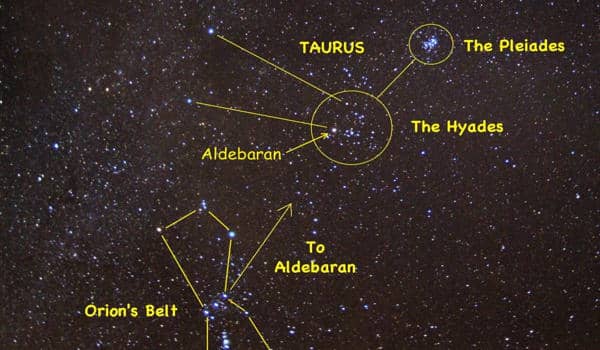Aldebaran (Alpha Tauri) is an orange giant star. It is the brightest star in the constellation Taurus and is known as the “Eye of Taurus.” It is about 65 light years away in the zodiac constellation of Taurus. It is older and redder than the sun and preparing to fuse its lightweight core into heavier elements, which is common among stars of its type. With an average apparent magnitude of 0.87 it is the brightest star in the constellation and is one of the brightest stars in the nighttime sky.
Aldebaran is the brightest star in the zodiac constellation Taurus. It is the fourteenth-brightest star in the night sky.
The name Aldebaran is Arabic and means “the Follower”, presumably because it rises near and soon after the Pleiades. It appears to follow the Hyades star cluster that forms the head of the bull. The diameter of Aldebaran is larger than 50 million kilometers. At 65 light-years away, the star is practically a neighbor to Earth. Its apparent magnitude is about 0.85, making it the 14th brightest star in the night sky.
Aldebaran is one of the easiest stars to find in the night sky, partly due to its brightness and partly due to being near one of the more noticeable asterisms in the sky. The star varies slowly in brightness between magnitude 0.75 and 0.95. This cannot be seen through the naked eye though. Following the three stars of Orion’s belt in the opposite direction to Sirius, the first bright star encountered is Aldebaran. Because the star’s luminosity is well understood, it is sometimes used for comparative astronomy.

The star is, by chance, in the line of sight between the Earth and the Hyades, so it has the appearance of being the brightest member of the open cluster, but the cluster that forms the bull’s-head-shaped asterism is more than twice as far away, at about 150 light-years. The star has a surface gravity of 1.59 cgs – around 25 times lower than Earth’s and 700 times lower than the sun’s.
Aldebaran is listed as the spectral standard for type K5+ III stars. It is around 17% more massive than our sun and it has around 30% less metallicity than it. Its spectrum shows that it is a giant star that has evolved off the main sequence band of the Hertzsprung–Russell diagram after exhausting the hydrogen at its core. It is around 6.4 billion years old – much older than our sun. The collapse of the center of the star into a degenerate helium core has ignited a shell of hydrogen outside the core and Aldebaran is now on the red giant branch (RGB). Its origins are unknown since it isn’t associated with any asterism, structure, cloud, or group of stars.
The effective temperature of Aldebaran’s photosphere is 3,910 K. It has a surface temperature of about 6,760 F (3,738 C) and glows red, similar to Mars — which occasionally passes by the star in the night sky. It has a surface gravity of 1.59 cgs, typical for a giant star, but around 25 times slower than the Earth’s and 700 times slower than the Sun’s. Its metallicity is about 30% lower than the Sun’s.
In 1993 a companion body was reported. Since the star is 5.47 degrees south of the ecliptic, it can be occulted by our Moon. A paper recently accepted shows evidence for a planetary companion. Due to its position in the sky, Aldebaran is sometimes called the Eye of Taurus.
Information Source:
















